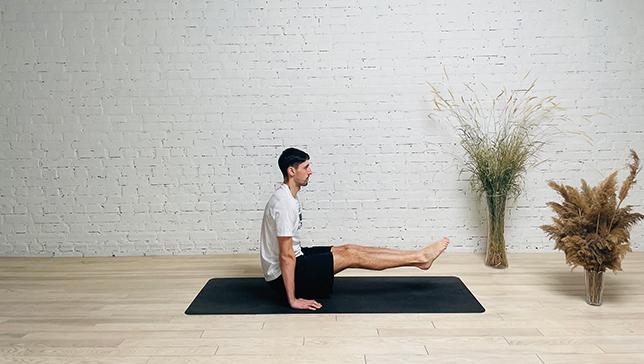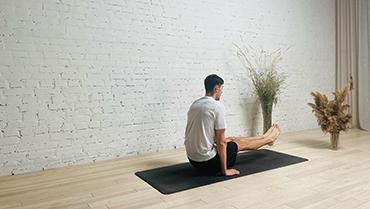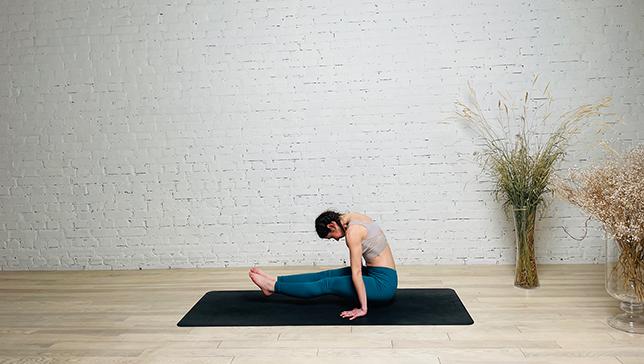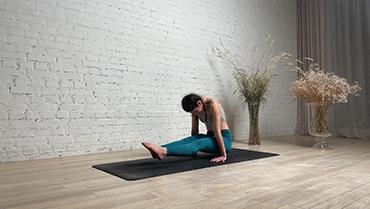Floating Stick Pose - Utpluti Dandasana

Contents
Floating Stick Pose, Flying Staff Pose or Utpluti Dandasana (oot-ploo-tee dahn-DAH-sah-nah) in Sanskrit, is a floating version of Staff Pose. It’s also referred to as Floating Staff Pose and Brahmacharyasana. From Staff Pose, the yogi places his hands on the floor outside of the thighs and uses core strength to lift the legs. Even an attempt to lift the legs builds core strength, and eventually, the legs float up with ease.
Utpluti Dandasana is thought to open the Muladhara (root) chakra. Opening this chakra is associated with physical and emotional grounding, providing energy, inner stability, and balance.
Floating Stick Pose requires core and arm strength, but the real key to floating above the earth involves unlocking energy flows through the feet, legs, and spine. Neither concentrated efforts to press with sheer arm strength, nor to pull up through abdominal muscles, will bring you into an energetic dance with the earth that allows you to float lightly from its gravitational pull. Instead, you will levitate into Floating Stick Pose by totally energizing your body into a firm and light stability and then elegantly counterbalancing its weight centers through breath-inspired counter-movements.
Pose Detail
- Body Position: Arm & Leg Support, Seated Yoga Poses
- By Type: Arm Balance Yoga Poses, Balancing Yoga Poses, Strengthening Yoga Poses
- Difficulty: Intermediate
Step-by-Step Instructions
Benefits and Contraindications
Stretches the hamstrings and hip flexors
Improves balance and coordination
Tones the abdominal muscles
Strengthens the arms, wrists, and shoulders
Builds focus and concentration
Boosts confidence and self-esteem
Carpal tunnel syndrome
High blood pressure
This pose is not recommended for pregnant women as it puts pressure on the abdominal area
Neck injuries
Wrist, elbow or shoulder injuries
Photo poses in different angles



Modifications and Props for Beginners
- If you find it difficult to lift your legs off the ground, you can use two blocks to support your hands. Place the blocks at shoulder-width distance and place your hands on them. This will reduce the weight on your arms and make it easier to lift your legs off the ground.
- Stand facing a wall and place your hands on the wall at shoulder height. Walk your feet back until your body is in a diagonal line, with your feet and hands supporting your weight. This will help you to build the necessary strength in your core and arms to lift your body off the ground.
- Loop a strap around your upper arms, just above your elbows. This will help you to keep your elbows in and your arms parallel to each other as you lift your body off the ground.
Useful Tips
Here are some tips and tricks to help you practice this challenging pose:
- Build core strength: Utpluti Dandasana requires significant core strength, so it’s important to incorporate core-strengthening exercises into your practice. Plank, Boat Pose, and Navasana (Boat Pose) are great poses to include in your practice to help build core strength.
- Build arm and shoulder strength: In addition to core strength, you’ll need strong arms and shoulders to lift your body off the ground. Incorporate poses like Chaturanga Dandasana and Dolphin Pose into your practice to help build arm and shoulder strength.
- Engage your core: As you prepare to lift your body off the ground, engage your core muscles by pulling your navel towards your spine. This will help you to lift your body with control and stability.
- Keep your gaze forward: As you lift your body off the ground, keep your gaze forward, towards the front of your mat. This will help you to maintain your balance and avoid tipping forward or backwards.
- Use your breath: Use your breath to help you stay focused and calm as you practice Utpluti Dandasana. Take slow, steady breaths as you prepare to lift your body off the ground, and continue to breathe deeply and evenly as you hold the pose.
- Practice with a teacher: Utpluti Dandasana is a challenging pose, so it’s important to practice with a qualified teacher who can guide you and offer modifications and variations to help you build strength and balance.
Remember to always listen to your body and practice with proper alignment. If you have any concerns or injuries, consult with a qualified yoga teacher or healthcare professional before practicing.
Frequently Asked Questions
No, Floating Stick Pose or Utpluti Dandasana is an advanced pose that requires a lot of strength, stability, and balance. It’s not suitable for beginners or those with injuries or medical conditions that affect their ability to practice arm balance poses.
Common mistakes to avoid when practicing Floating Stick Pose include not engaging the core muscles, not keeping the elbows close to the body, and not maintaining a straight line from the head to the feet.
Yes, Floating Stick Pose should be avoided if you have any injuries or medical conditions that affect your ability to practice arm balance poses. It should also be avoided if you have high blood pressure, wrist or shoulder injuries, or any other medical condition that affects your ability to bear weight on your arms. It’s always important to listen to your body and practice yoga safely.
Variations
- One-Legged Floating Stick Pose
- Floating Stick Pose Near The Wall
- Floating Stick Pose With A Blocks